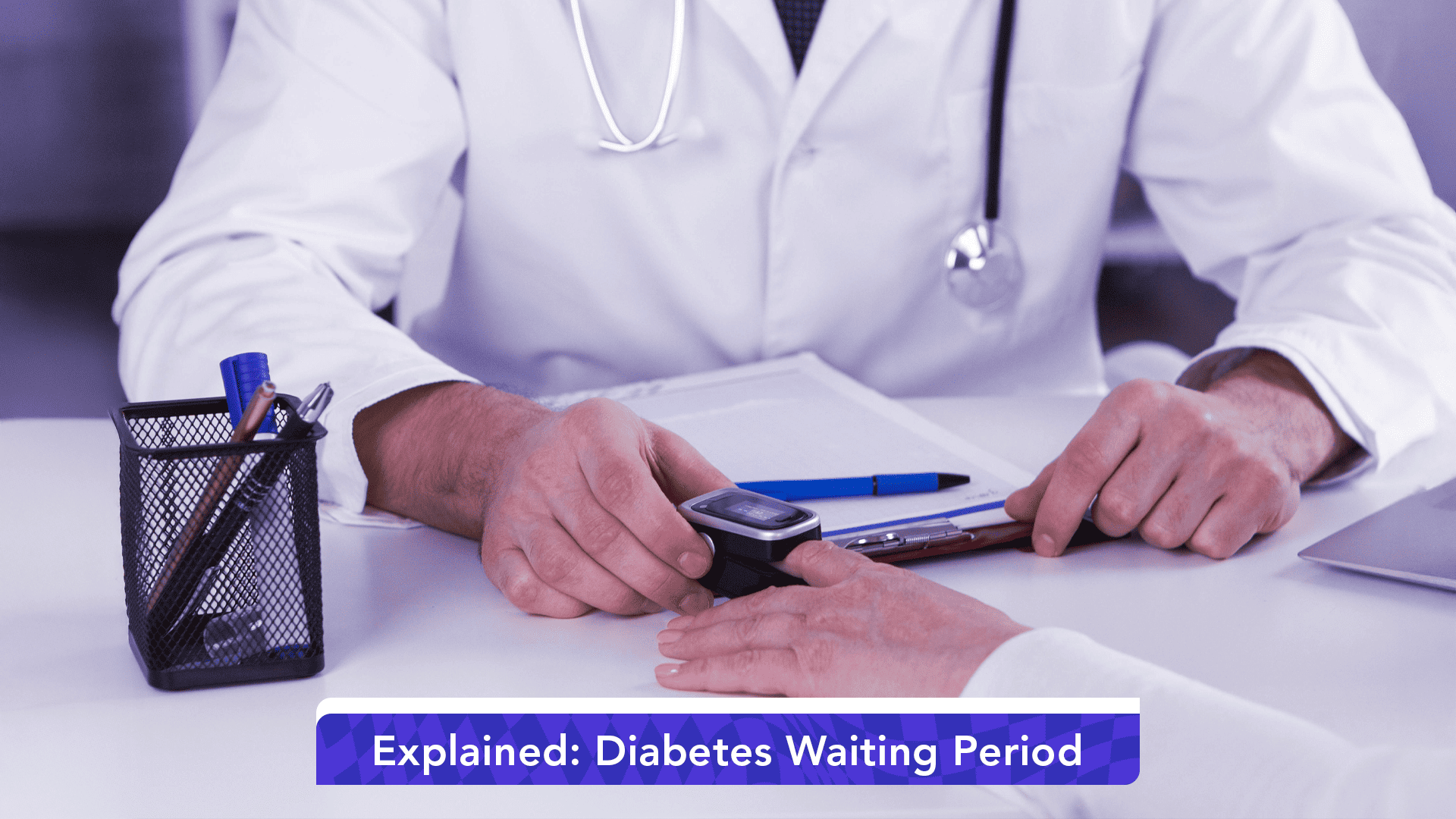Can I get insurance if I’m diabetic?
Will my premiums be higher?
Will insurance pay for my insulin?
If you’ve ever asked (or feared) these questions, this post is for you. To answer these questions, we need to get into the details.
India now has roughly 101 million (10+ crore) people living with diabetes and another 136 million with pre‑diabetes – The highest numbers in the world.
With something so common, you’d expect buying health insurance to be straightforward. Yet, many policies include diabetes in fine print and “waiting period” clauses that can feel like hidden traps.
Let’s decode what insurers cover (and when), and compare the big names so you can choose with eyes open.
First, what on earth is a “waiting period”?
In health insurance, a waiting period is the time you must remain insured before the company will cover certain treatments. While coverage for accidents typically begins from Day 1, other types of treatments have specific waiting periods:
- Initial waiting period: 30–90 days after you purchase the policy (accidents are usually covered from the policy’s effective date).
- Pre‑Existing Disease (PED) waiting period: Applies to illnesses you already had—like diabetes. Traditionally, 2–4 years, but read the next section for an important update.
- Specific disease/procedure waiting period: A set list (e.g., cataract, hernia, joint replacement) often 1–3 years.
- Maternity waiting period: Commonly 9–36 months.
Reducing the Wait: Add-ons That Speed Up Coverage
Some insurers offer zero- or reduced-waiting-period options through special plans or riders. These can significantly cut down the PED waiting period—sometimes to as little as 0–12 months—in exchange for a higher premium.
The rule change you should know (IRDAI update)
India’s regulator, IRDAI, trimmed the maximum PED waiting period from 4 years to 3 years (36 months) in 2024. Insurers can’t keep you waiting longer than that for disclosed pre‑existing diseases like diabetes.
Bottom line: If you’ve stayed continuously insured for 3 years, the company cannot reject a diabetes claim just because it was “pre‑existing”—unless you hid it or misrepresented facts.
Note: Some insurers are still updating their brochures, so you might see older documents that say “4 years.” Be sure to check for the latest wording or any recent updates (endorsements) to ensure you have the correct information.
Patterns you can use to your advantage
- Dedicated diabetes plans help. Star’s Diabetes Safe and Care Freedom are designed for diabetics who offer shorter waits, fewer hoops.
- PED waiver riders. Reliance lets you pay extra to cut the wait to 12 months. Others may follow.
- ManipalCigna’s 90‑day trick. If your diabetes is mild and controlled, that 3‑month wait is the shortest mainstream option.
- Porting preserves credit. Been insured elsewhere? When you port, your completed waiting period usually carries forward (as a court just reminded an insurer).
- Regulatory cap = bargaining chip. If a policy still says 48 months, ask for the updated wording or move on.
Example timeline: How Waiting Periods Play Out in Real Life
Say you buy a plan on 1 Aug 2025 with a 24‑month PED wait for diabetes.
- 1 Aug 2025 – 31 Aug 2025: Initial 30-day period. Only accidents are covered.
- 1 Sep 2025 – 31 Jul 2027: Diabetes related claims are not covered.
- From 1 Aug 2027: Complications arising from Diabetes are payable (subject to policy limits, co-pay, etc).
Before You “Buy a Policy”: Questions You Must Ask
- What exactly is the PED waiting period for diabetes? (Ask for it in writing/email.)
- Is there a disease-specific wait on top of the PED wait?
- Can I buy a rider to shorten or waive the wait? How much does it cost?
- Do I need a pre-policy medical test? If yes, who pays?
- Any co-pay or sub-limits on room rent, ICU, dialysis, insulin pumps, etc.?
- How soon do I need to notify claims for OPD or hospitalization?
- Will my wellness score or steps tracked reduce premiums or waiting times?
- If I already have insurance, will porting carry forward my waiting period credit? (It should.)
- Are there exclusions for experimental treatments or AYUSH?
- Finally, get the policy wording PDF—not just the brochure.
How Top Insurers in India Handle Diabetes Waiting Periods (At a Glance)
This is a general overview based on publicly available information. Make sure to check the latest details on each insurer’s official website before making a decision.
- Star Health – Diabetes Safe (Plan A/B): Plan A has virtually no wait for diabetes complications; Plan B has 12 months.
- Care Health – Care Freedom: PED wait is 24 months for diabetes/BP; fewer pre-medical hassles.
- ManipalCigna – ProHealth Prime Active: 90 days for diabetes/Hypertension, 2 Years for other PEDs.
- Reliance General – Health Gain/Infinity: 3-year PED standard; rider can cut to 1 Year.
- Niva Bupa (ReAssure, etc.): Commonly 3 Years, check for riders or newer plan variants.
- Aditya Birla Health (Activ series): Typically 36 months, strong on wellness rewards, not on PED waiver.
- ICICI Lombard: Often 2 Years for PED.
- HDFC ERGO: Historically 2–4 years, now capped at 3 Years after IRDAI rule. Watch for updated endorsements.
- Bajaj Allianz / Tata AIG / SBI General: Expect 1–4 years depending on the plan. Confirm the updated caps.
Smart Tips for Insurance Buyers
- Never hide diabetes: Non-disclosure can nuke your claim later. Better to pay a bit more and be safe.
- Track every communication: Save emails, chat transcripts, and call recordings if possible. When claims get messy, paper trails save the day.
- Review Annually: Plans evolve. A better diabetes-friendly product might appear next renewal—porting is your friend.
- Think beyond hospitalization: Many diabetes costs are OPD—consults, test strips, sensors. Some plans now offer OPD riders; see if they’re worth it.
- Watch out for related health issues: Hypertension, cholesterol, thyroid, these often travel with diabetes. Ensure they’re not treated as separate PEDs with separate waits.
Final words
Buying a health insurance policy shouldn’t be confusing, especially when you’re already managing blood sugar, diet plans, and regular lab tests. Use IRDAI’s new 3-Year cap on PED waiting periods to your advantage and pick a plan that respects your condition.
If anything still isn’t clear, Inkasure is here to help you—just ask in plain English. We would be happy to answer any questions.
Stay protected, stay at peace. 🧡




